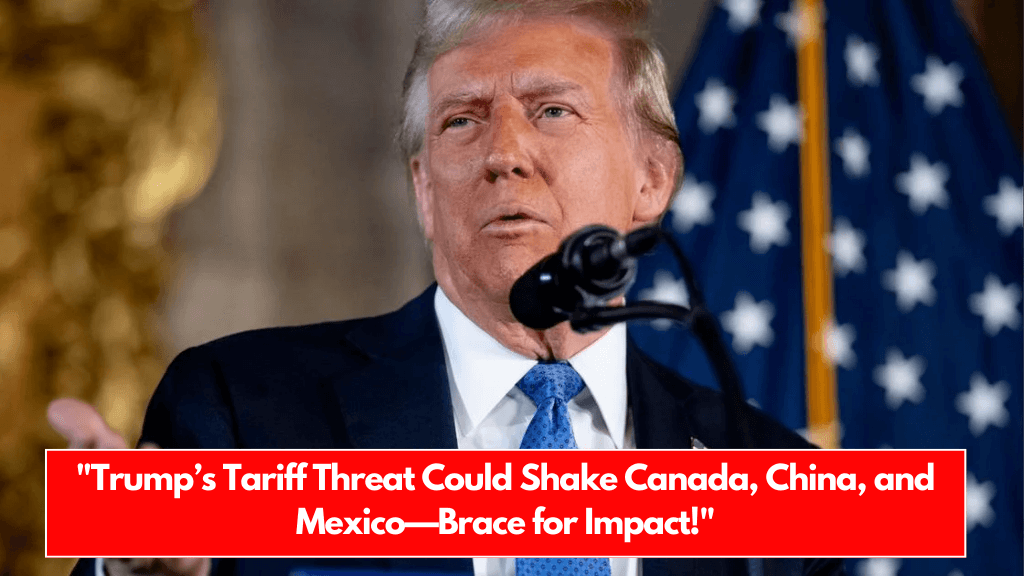On the day of his inauguration, President Donald Trump threatened new tariffs against key U.S. trading partners like Canada, Mexico, and China. His administration could soon deliver on these threats, potentially shaking up global trade, economic growth, and consumer prices.
Here’s a breakdown of why Trump is considering tariffs, what he may impose, and how this could impact the U.S. and other nations.
Why is Trump Threatening Tariffs?
Trump’s tariff threats target Canada, Mexico, and China for several reasons, including halting the flow of undocumented immigrants and combating drug smuggling into the U.S.
For example, Trump has linked tariffs to efforts to curb the illegal entry of fentanyl, a deadly drug largely produced in China and trafficked through Mexico.
He previously warned of tariffs as high as 60% on Chinese imports during his first term to pressure Beijing into negotiating better trade terms.
His administration has also shown that tariffs can be a tool to secure concessions on non-trade matters. For instance, Colombia agreed to accept the return of deported unauthorized immigrants after Trump threatened a 25% tariff on Colombian goods.
This approach suggests that Canada and Mexico could potentially avoid tariffs by cooperating with U.S. demands. Howard Lutnick, Trump’s nominee for commerce secretary, stated during his confirmation hearing that Canada and Mexico could avoid tariffs by closing their borders to fentanyl.
What Tariffs Could Be Imposed?
Experts say Trump’s tariffs could take several forms. His administration may target individual countries like Canada, Mexico, and China or impose broader tariffs covering goods from various regions, including Asia, Europe, and South America.
As of now, Trump has signaled that:
- Canada and Mexico could face 25% tariffs on certain imports starting Feb. 1.
- China may face a 10% duty on its exports to the U.S.
The exact scope and structure of these tariffs remain unclear. Brett House, an economics professor at Columbia Business School, noted that Trump’s trade announcements often leave room for uncertainty.
“There’s a storm of possibilities,” House said, suggesting that some announced tariffs may never materialize, while others could be implemented suddenly.
The administration could quickly impose tariffs using the International Emergency Economic Powers Act of 1977, which allows the president to act during crises.
How Could Other Countries Retaliate?
Economists agree that U.S. trading partners will likely respond with their own tariffs if Trump’s proposals move forward.
- Canada: Experts expect Canada to retaliate with a 25% across-the-board tariff on U.S. imports, affecting a wide range of goods.
- Mexico: Rather than targeting U.S. manufacturing imports (which are essential to Mexico’s exports back to the U.S.), Mexico could impose tariffs on agricultural and food products.
Such retaliatory measures could escalate tensions and harm industries on both sides of the border. For example, Canadian tariffs could affect American dairy, auto parts, and steel exports, while Mexican tariffs on U.S. agricultural products could hurt American farmers.
Potential Impact on American Consumers
If Trump’s tariffs take effect, U.S. consumers could see higher prices on a variety of goods, from electronics to groceries. Companies typically pass added costs from tariffs onto consumers, leading to price hikes.
Economists, including Dartmouth’s Douglas Irwin, warn that consumer price inflation could rise significantly, with some estimates predicting a 3% to 4% increase if a universal 10% tariff is imposed.
The administration’s belief that gradually increasing tariffs in 5% increments will minimize inflation is misguided, said Gregory Daco, chief economist at EY-Parthenon. He explained that even small but steady price increases can raise inflation expectations, pushing prices higher over time.
If inflation rises, it could complicate the Federal Reserve’s plans to ease monetary policy, potentially slowing down economic growth.
The Risks of a Trade War
Trump’s strategy of using tariffs as leverage could deliver short-term wins, as seen in the case of Colombia’s cooperation. However, economists caution that the long-term risks may outweigh the benefits. Retaliatory tariffs could harm U.S. exporters, disrupt supply chains, and strain relationships with key allies.
Additionally, tariffs could hurt American manufacturers that rely on imported raw materials or intermediate goods, making their products more expensive to produce. This could lead to job losses and reduced competitiveness in global markets.
President Trump’s proposed tariffs signal a shift toward using trade policy as a tool for achieving broader political goals. While this approach may force trading partners to negotiate, it also introduces significant risks, including price inflation, trade retaliation, and strained international relations.
As the administration weighs its next steps, businesses, consumers, and policymakers will be closely watching the potential economic fallout.
